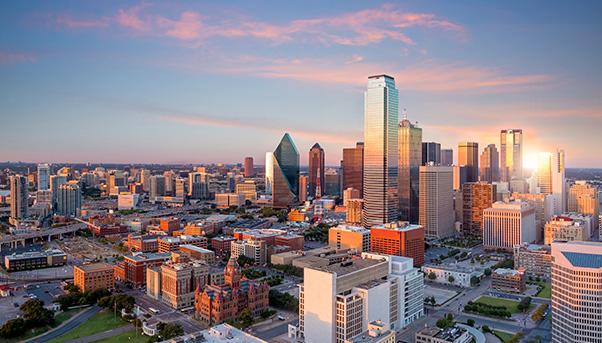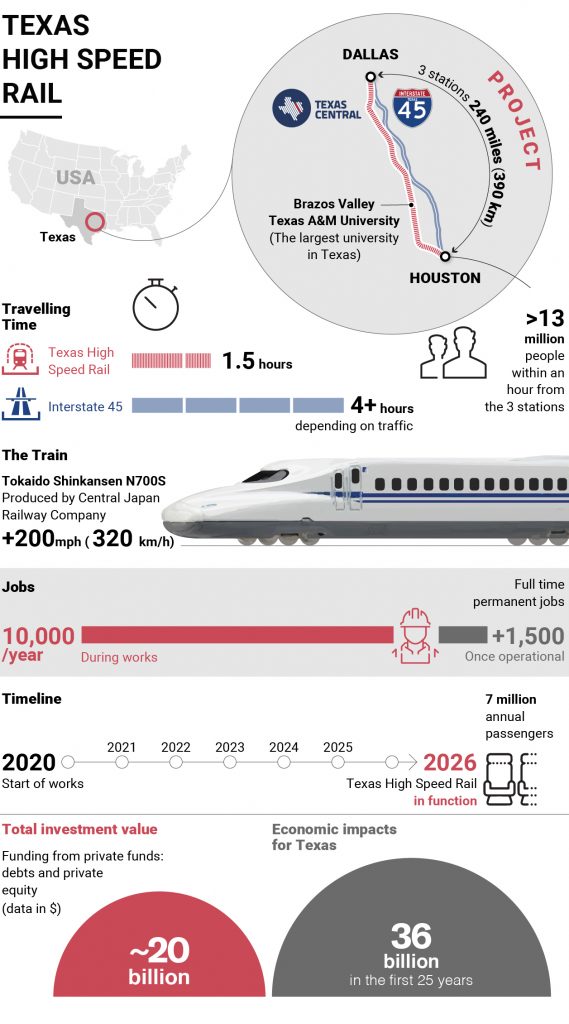
More than once a week, almost 50,000 super-commuting Texans travel from Houston to Dallas. Then there are the tens of thousands more who move between the two cities on a regular basis, creating traffic congestion on one of the USA’s most important highways.
Now this may change. Project developer Texas Central said it is nearing construction of the country’s first high-speed train that will travel the distance between Houston and Dallas/Fort Worth in just 90 minutes. This ultra-modern train will run every 30 minutes during peak hours, making a giant step forward for the state in terms of sustainable mobility.
All this and more makes it the largest infrastructure project in the history of Texas and the first of its kind in the United States of America. Texas Central is the company undertaking all aspects of the project, from design to finance, for what it calls «an unprecedented multi-billion-dollar investment for the future of the state».
The train’s economic benefits
Shortening the travel times between two major cities like Houston and Dallas has a significant economic impact, which will allow private companies that invest in the project to recoup the approximately $20 billion estimated total construction cost. According to the calculations by independent analysts cited by Texas Central, the new train will create a cumulative economic impact of $36 billion in its first 25 years. Moreover, in the five to six years necessary to build the rail link, 10,000 jobs will be created, plus thousands more indirect jobs.
«Over 25 years, the project is expected to pump more than $36 billion directly into state and local economies», said Drayton McLane Jr, Texas Central Chairman, in an open letter published on its website. «These benefits will be in the form of direct spending, increased employment and new economic activity generated by the project all along the route».
Moreover, the company calculated that the high speed train will generate billions of dollars in tax revenue for Texas and local administrations in that time.
«The Texas train is a transformational project that is generating attention and excitement among infrastructure experts who recognize it as a catalyst for creating jobs, boosting the economy and providing a much-needed transportation choice», said Texas Central CEO Carlos Aguilar.

Respect for the community
Texas Central opened a dialogue with the Federal Railroad Administration (FRA) to identify the best route along which the train will run. The FRA analyzed all the possible solutions to minimize the community impact, and looked at all the best route for the environment. The identified routes were then socialized with landowners for their input.
This same approach was used to choose the location for stations, which will be placed near the main highways and at public transport connections.
Today there are three planned stations: one in Dallas, in the Cedars area; one in Brazos Valley, an intermediate stop located between North Texas and Houston; and the third in the city of Houston.
Who is financing and building the train
The high-speed train between Houston and Dallas is a complex infrastructure costing approximately $20 billion to build. It will be financed by private investors, not the federal government or the State of Texas. Texas Central has emphasized its commitment not to utilize state and federal grants.
Partners for the design and construction of the civil work are Salini Impregilo and Lane Construction Corporation (Salini Impregilo subsidiary), together in the “Texas High Speed Rail LLC” joint venture.
Everything seems ready for work to start. The dream of America’s first high-speed train is beginning its journey to become reality.
A train for future generations
The intermediate stop between Dallas and Houston in the Brazos Valley will serve thousands of Texas A&M University students, researchers and academics every day. Founded as the Agricultural & Mechanical College of Texas in 1871, it is today the second largest university in the United States in terms of number of students, with around 64,000, compared to 66,000 at the University of Central Florida in Orlando.
A&M has more than 12,000 engineering students, with international connections and campuses in Qatar, where among other things the Salini Impregilo group is building a metro line and one of the stadiums for next World Cup football championships.

